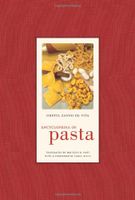Filindeu
Unusual shape
Published 2009

To make the woven sheets, a small amount of dough is pinched off and rolled with hands until long and thin. It is then folded in half eight times. During this process, the hands are moistened with salted water. With the last fold completed, the result is a skein of 256 very thin threads. These threads are laid on a wooden disk called a fondo (bottom), and then cut around the edge. The operation is repeated with additional layers of pasta threads and, with each layer, the fondo is turned ninety degrees. When the fondo is completely covered, a second layer of fine threads is placed at right angles to the first layer. Finally, a third layer made the same way is placed atop the other threads at oblique angles. The fondo is set on a special trestle and placed in the sun, where the pasta is left to dry, forming a sort of thin gauze. It is broken into seven large pieces, and the pieces are kept well wrapped in special paper. Just before cooking, each piece is broken into small pieces.
Part of
Advertisement
Related Recipes
-
-
-
-
Related Reference
-
-
-
-
Advertisement



